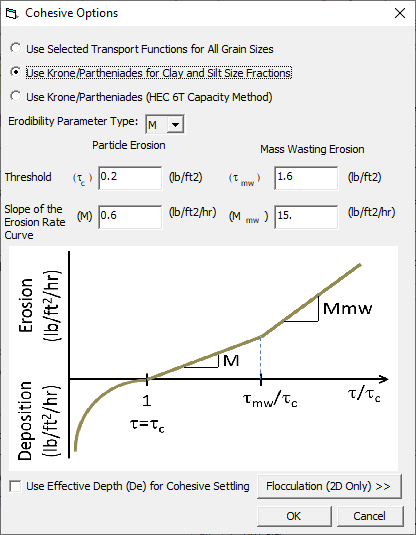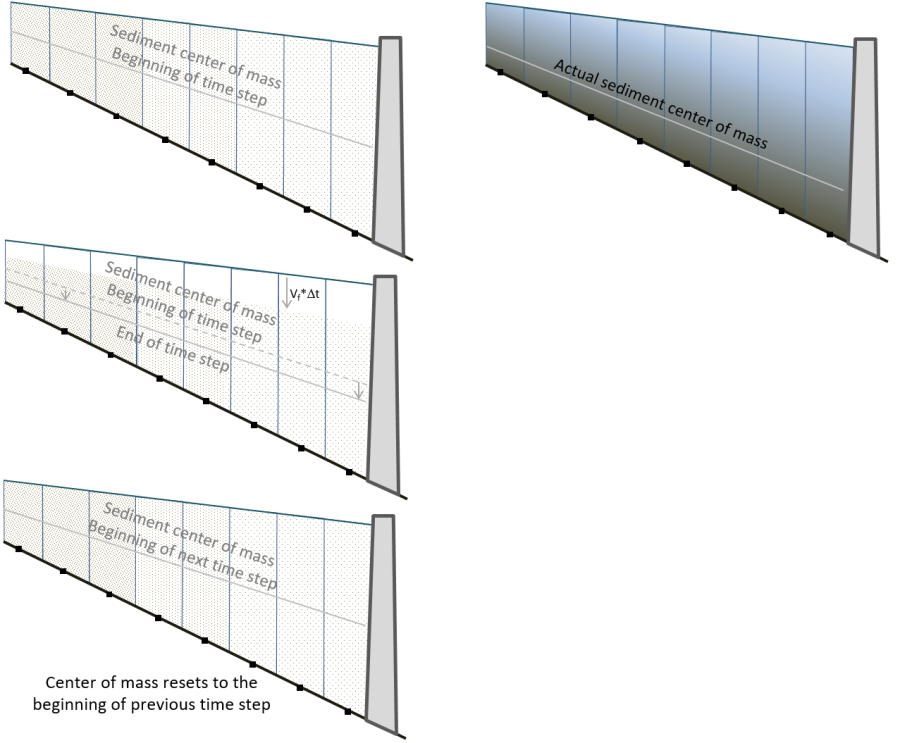Download PDF
Download page Cohesive Options.
Cohesive Options
Cohesive methods and parameters can be specified by selecting Set Cohesive Options under the Options Menu. The method selected will be applied to the first five grain classes (GC 1-5) which are silts and clays in the default grain classes (but will apply to the first five grain classes regardless of size if the user edits them).
HEC-RAS can either compute fine particle transport with the standard transport capacity approach - using the selected transport function to extrapolate transport potential for the silt and clay grain classes outside of the developed range of these equations, or with the Krone and Partheniades equations. 
HEC-RAS includes two versions of the Krone and Parthinades equations, the HEC-RAS method from previous versions and the HEC 6T method. See the Technical Reference Manual for formulations of Krone and Partheniades as well as a description of the difference between HEC-RAS and HEC 6T methods. Both use the thresholds and slopes, computing erosion rates in the same way. However, once erosion rates are computed, the methods apply them to the multi-grain class bed materials differently. The methods have several differences, but mostly the HEC-RAS method distributes the erosion rate over all grain classes while the HEC 6T applies it to each (after reducing it based on inflowing load). The HEC 6T method generally computes more erosion.
Method
HEC-RAS includes three methods for modeling cohesive transport. Modelers should be aware that The Default Method is Not Recommended. Cohesive transport should be parameterized using the Krone and Partheniades approaches, especially if the system erodes cohesive materials.
Modeling Note: Parameterizing Cohesive Transport
Cohesive transport parameters can be difficult or expensive to collect, but are also highly variable (spanning at least five orders of magnitude) and site specific. They should either be measured with a SedFlume (Briaud, 2008; USACE, 2012) or similar apparatus or jet tests in the field or should be the primary calibration parameter. SEDFLUME analyses are available at the US Army Corps of Engineers Engineering Research and Development Center (ERDC-CHL, formerly WES) or at a handful of universities. ERDC-CHL can also conduct jet tests as well as the USDA-Agricultural Research Station and several universities, districts and contractors. See the Cohesive Parameter Estimation section of the Technical Reference Manual for more information on this and some example data.Modeling Note: Bed-Material Load Modeling Option
If the fine sediment in the model is wash load, and is not interacting with the bed, it may be appropriate to ignore it, and remove it from the model. Removing wash load avoids the uncertainty and numerical artifacts of transporting fine sediment with transport functions developed for cohesionless sediment and avoids speculating about uncertain cohesive parameters. Alternately, setting the erosion threshold low enough that wash load remains in suspension is another approach to keeping wash load in your model, without detailed cohesive sediment data. However, if the objective of the model includes cohesive erosion, these parameters must be measured and/or calibrated.Erodibility Parameter Type:
There are two forms of the excess shear equation: the dimensional equation (Kd) and dimensionless equation (M). The erodibility parameters in these equations are not equivalent and have different units. They are related to each other by the critical shear stress:
| M = K_d \tau_c |
See the M-Kd Section of the Technical reference manual for more discussion of these two equations. But the critical consideration is that users must make sure they understand which form their data are in. Selecting the appropriate Erodibility Parameter Type:![]()
Will change the units in the interface and align your data with the correct form of the equation.
Modeling Note: Linear Erosion Model
HEC-RAS requires all four parameters, even if your erodibility data suggests a linear model (e.g. only one Erodibility slope). To simulate a linear shear-erosion rate relationship, make the two erosion rates the same and/or set the mass wasting threshold stress much higher than the shear stresses in the simulation.Modeling Note: Reservoir Cohesive Deposition
Despite the volume default effects described in the previous note, HEC-RAS under predicts cohesive deposition – particularly in reservoirs - more often. There are several reasons for this.
- The Continuity (Exner) equation is just a mass balance model and does not track longitudinal transport physically, like the Advection-Diffusion approach. If the control volume depth is large relative to the distance between cross sections (e.g. the sediment Courant condition is <<1), the Exner equation will not compute enough residence time to compute appropriate deposition with fall velocity-based approaches. Always use the Limit to Water Velocity method, (Sediment Data->Options->Transport Methods: 1D Routing Method) when simulating reservoirs or other low Velocity depositional zones:

- HEC-RAS fully mixes sediment vertically at the beginning of every time step, forcing the sediment to settle out of the whole water column. In a reservoir with high residence time, the center of mass of the cohesives may drop below the center of mass of the water over time (and space). HEC-RAS 6.0 gives users some opportunity to influence the vertical mixing of each cohesive grain class vertically, by extending the effective depth to the cohesive deposition equation
 , but it is still a limitation of the model.
, but it is still a limitation of the model. - Aggregates and flocculation – Cohesive sediment often transports in aggregates or flocs – which are clusters of combined cohesive particles. These behave like larger particles, with higher fall velocities, and deposit more quickly (giving reservoirs higher trap efficiencies for aggregate cohesives or estuaries higher trap efficiencies for flocs)
Therefore, it is often appropriate to "coarse" the fines in the boundary load gradation to offset these biases and calculate more cohesive deposition during the calibration process if HEC-RAS is under predicting compared to the prototype. 